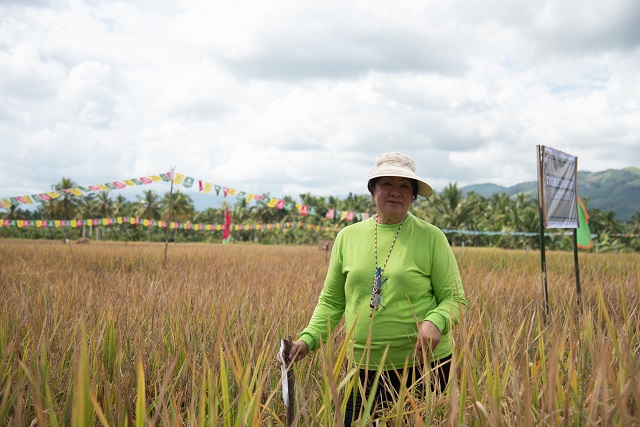
Our breeders scored high in 2019 as the National Seed
Industry Council released 10 of their new varieties.
NSIC 2019 Rc 522H (Mestiso 103), is a hybrid variety
released on March 11, 2019 – a product of PhilRice-UP Los Baños collaboration.
The other new varieties are four rainfed (NSIC 2019 Rc 568,
Rc 572, Rc 574, and Rc 578); one saline (Rc 558); and 4 coldtolerant (Rc 560,
Rc 563, Rc 564, Rc 566).
The cold-tolerant rices are also known as Cordillera 1, 2, 3, and 4 bred by a team led by Thelma F. كازينو اون لاين الكويت Padolina, now our senior research fellow.
First of its kind
Padolina said these varieties were bred specifically to suit
growing conditions in high-elevated areas in the Philippines. Varieties planted
in fields 800 meters above sea level need to have tolerance to cold
temperatures to produce decent yields. The Cordillera series can thrive in
lower than 18.8 degrees Celsius, which is not a comfortable temperature for
ordinary rice.
The new varieties also have good eating quality. Based on
amylose content, they are comparable to NSIC Rc 160, the now popular aromatic
variety also bred by Padolina. The cold-tolerant rices, however, mature longer
at 142-145 days.
The Cordillera series have moderate resistance to blast,
which is widespread in highly elevated areas. “These are of the indica-japonica
cross, meaning they have semi-circular or bold grains. This results in high
milling recovery at 70%, compared with the national average of 65%,” Padolina
explained.
She also shared that their names were decided by a technical
working group. Varietal names should also depict the ecosystem that they were
made for: tubigan , sahod-ulan , salinas , and katihan .
“Since Cordillera is a high-elevated area, we figured out
that this name would make it obvious that the varieties are cold-tolerant. For
the first time, ‘Cordillera’ was borrowed to popularly identify rice
varieties,” the principal breeder who compulsorily retired in 2015 said.
Worth waiting for Padolina recalled that Cordillera 1, 2, 3,
4 already passed the standards of the National Cooperative Tests in 2010.
However, it took some 10 years before these were finally released owing to a
shift in research priority, where adverse conditions became less priority.
“I understand that there’s constraint when it comes to
budget, so we had to prioritize the major ecosystems in our country. Our
cool-elevated areas are much smaller. Most of them are in the Cordillera region
in Luzon and in Bukidnon in Mindanao,” Padolina pointed out.
But she did not abandon her research on cold-tolerant
varieties by holding on to her partners and other externally funded projects.
Her Germplasm Utilization for Value Added (GUVA)
collaboration helped her to include materials in the project’s testing site in
Benguet, a cool-elevated area.
Padolina also joined the Temperate Rice Research Consortium
of the International Rice Research Institute, together with temperate countries
such as Turkey, Russia, Egypt, and USA. The germplasms from 23 countries under
the consortium, including the Cordillera series, were tested in South Korea,
where field screening has automated temperatures.
Under this consortium, our Cordillera series showed
comparable performance to materials from USA, with each group scoring a 5
(moderate cold-tolerant) under the screening temperature of 17 degrees Celsius.
The Cordillera materials then underwent on-farm trials in PhilRice Isabela in 2015-2017, and in Benguet as well.
Gearing for the next step
After their approval, the next step is commercialization.
Nucleus and basic seeds of these varieties are now housed at PhilRice. دومينو
The varieties are to reckon with Participatory Performance
Testing and Validation (PPTV) in target sites by 2021 dry season to customize
their adaptability. By that time, breeders would have already ensured the
authenticity of the seeds, including those for the PPTV. Breeder and foundation
seeds will also be propagated.
“In PPTV, released varieties are tested in farmers’ fields
depending upon the requests of the regions,” the seasoned breeder added.
Padolina explained the need to develop cold-tolerant
varieties.
“Climate change makes the world a little more challenging
than it was before. Varieties no longer excel very long in the field. Based on
studies, they need to be replaced every 3-5 years.”
Until now, cool-elevated areas are still not classified
under adverse conditions. The focus is on areas with high temperature. لعبة عبر الانترنت
“History has it that the last cool-elevated variety released
was NSIC Rc 104. It was made available under JICA, and I was one of the breeders
who worked on it,” she added.
Padolina cited pests mutation, technology change, and
diversity in environment as to why farmers need location-specific varieties
like the Cordillera series. “The thing is, no one can really breed a perfect
variety.”




